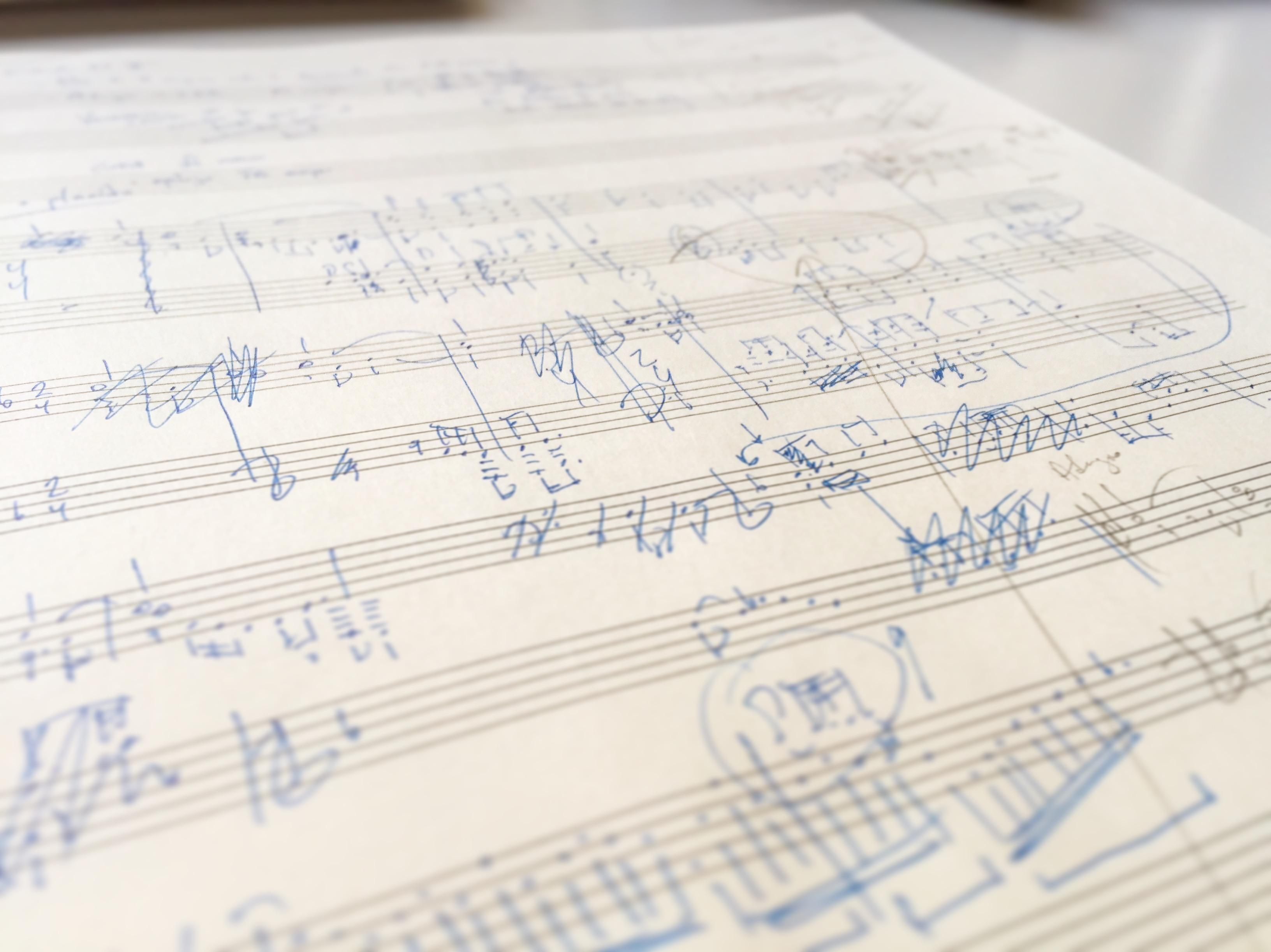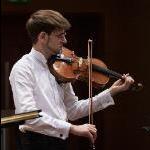-
Posts
14 -
Joined
-
Last visited
About Rodrigo Ruiz

- Birthday 10/06/1988
Contact Methods
-
Website URL
www.rodrigoruiz.com
Profile Information
-
Gender
Male
-
Location
Rome, Italy
-
Occupation
Composer
-
Interests
Literature, mythology, theatre, opera, nature
-
Favorite Composers
Beethoven, Brahms, Wagner, Mozart
-
My Compositional Styles
Classical
-
Notation Software/Sequencers
Dorico
-
Instruments Played
Piano
Recent Profile Visitors
Rodrigo Ruiz's Achievements
-
NiceyMcNice started following Rodrigo Ruiz
-
_Small-3.thumb.jpg.b0a4415d512176e6fbce5cfa1e8ad246.jpg)
Sonata for violin and piano in F major, R. 6
Rodrigo Ruiz replied to Rodrigo Ruiz's topic in Chamber Music
@pianist_1981 Thank you for your encouragement. I really appreciate it. We were very lucky, indeed, to have recorded before the pandemic broke out (at least in our part of the world). We were originally going to launch around these dates, but we've had to move it to next year. The official launch date with Signum Classics is set for 19 March 2021.- 16 replies
-
- 1
-

-
- violin
- chamber muisc
-
(and 3 more)
Tagged with:
-
Rodrigo Ruiz started following SUMMER 2020 COMPETITION SUBMISSIONS THREAD
-
_Small-3.thumb.jpg.b0a4415d512176e6fbce5cfa1e8ad246.jpg)
Sonata for violin and piano in F major, R. 6
Rodrigo Ruiz replied to Rodrigo Ruiz's topic in Chamber Music
Hi @Vogel! It's been a real pleasure chatting with you. Yes, definitely, take up composing. The right time is always 'now'. There's nothing else we have, right? I'm sure we'll continue to have many an intellectually and artistically rewarding conversation. In the meantime, receive my very best! RR- 16 replies
-
- 1
-

-
- violin
- chamber muisc
-
(and 3 more)
Tagged with:
-
_Small-3.thumb.jpg.b0a4415d512176e6fbce5cfa1e8ad246.jpg)
Sonata for violin and piano in F major, R. 6
Rodrigo Ruiz replied to Rodrigo Ruiz's topic in Chamber Music
Hi @Vogel! Allow me to begin by thanking you for going out of your way to spend some time with the music, both through listening and through a careful analysis of the score. Your comments are very well informed and very helpful. I must say that in my time at the conservatory and music school, I was led to believe by the faculty (and others) that my music, being written in a Classical—Romantic idiom, as you've correctly pointed out, would not be interesting for performers or the music industry in general. Thankfully, I have found that to be far from the truth. (Although it is true, and I have inside information, that many composition competition panels throw tonal music scores to the trashcan without even looking at them.) Ah! Yes, the old dilemma about sonata form. I found your observations keen, and some of your conclusions very interesting and novel. All of them have some validity, of course. I can only say that I was indeed thinking of sonata form. Now, using the term 'traditional sonata form' is to walk into quicksand. Let me just say that the strategies that I used to lay out the sonata form were all found in real musical examples in the works of Mozart and Beethoven, primarily. What might have thrown you off for a while is the fact that the first theme, in a typically Mozartean fashion, is comprised of two very different modules (if only on the surface, for there are many underlying connections between them). Therefore, b. 28 is obviously the beginning of the exposition proper with what we could call Theme 1.A, and then comes Theme 1.B at b. 40, which leads back into a second (variated) iteration of Theme 1.A. As you can see, our first theme is actually in ternary form itself (1.A – 1.B – 1.A'), which is exactly what Mozart does in his E minor Violin Sonata (K. 304), albeit at a much smaller scale (20 bars in all, compared to my 32 bars). I had to extend to 32 bars in order to balance the introduction which is fairly substantial. And this exposition is itself balanced in the recapitulation by the abridgment (or omission) of several modules—which, again, Mozart does. Bars 59-68 are a transition into the second theme which is in the surprising key of A-flat minor, which closes at b. 77 with a PAC in A-flat minor. Why the key? Well, the end of the Introduction cadences in that same key (b. 23) before modulating to F major, and the initial motion of the opening bars of the sonata the violin clearly delineates F-G-A flat. Not only that, but when the upper voice leaves the F pedal, the first note it touches is A flat. There are plenty more, but you get the point. The development proper (b. 85) goes through various modules before reaching the recapitulation (b. 118), which uses the first theme's 1.B module, rather than module 1.A—yes, you guessed it: Mozart also does this. This brings novelty, especially since a lot of module 1.A is used in the development. It also helps to balance the quite extensive first theme in the exposition, as I said before. Module 1.A (technically 1.A') still makes an appearance at b. 126. The rest is pretty straightforward, paralleling the exposition, until we reach a bar of silence which leaves the music hanging on a dominant seventh chord. After that we get a coda to further balance the introduction out (b. 171—end of movement). In the end, the form is only secondary, and what's important is the effect and overall impression and proportions of the movement or work. I'm glad you found this particular model 'refreshingly original.' By the way, are you familiar with (or have you read) 'Elements of Sonata Theory' by James Hepokoski and Warren Darcy? I had never found a study of sonata form based so thoroughly in facts and that looked at the repertoire itself trying to understand it without trying to force it into a pre-conceived idea of form—something which we know came after the fact, since a definition of sonata form is not to be found anywhere in any book or writing in Beethoven's or Mozart's time. I highly recommend this book (along with a careful analysis of the repertoire, leaving behind old ideas) to anyone interested in understanding sonata form as it was understood in the time of Haydn, Mozart and Beethoven. Yes, you're right. I will only add that this diminished chord contour does not come out of the blue (you didn't imply that, by the way). It is taken directly from the First Theme (module 1.A) of the first movement. Three descending notes by step, followed by a leap upward in the opposite direction; the context here is a diminished chord, whereas in the first movement it was a major chord. (The module 1.A from the first movement was itself taken from the introduction—look at the violin in b. 17–18). That is exactly the feeling I wanted to convey, Vogel. The second movement, although a movement on its own, is on the verge of feeling as an introduction to the third movement. Or, as you've pointed out, 'a cantabile ['arioso' might be closer?] to the third movement's cabaletta. Again, the theme of the third movement is taken from the very beginning of the work. Remember the first three notes of the violin? F—G—A flat. These are precisely the notes that the piano lingers on if you where to take the bones out of the flesh, if you take my meaning. E–F (x2) followed by G—A flat (x2). Furthermore, the ascent up to D flat (b. 3–5) is exactly what the violin does in the opening bars of the sonata. You're starting to catch the motivic relations. Now that I've pointed out some more of them, you might be able to see yet others. It was definitely intentional. I couldn't pick between them—what father can choose one amongst his sons as a favourite? But you are welcome to pick 😉 Thank you for the encouragement, Vogel. There's much I need to work on, definitely. One step at a time! The pleasure is all mine! I'd be happy to keep a conversation going. I greatly enjoy sharing ideas with you. I will definitely take you up on that and send you new works for you to review. Please feel free to send me your things as well, if you'd like. (May I ask you if you write music criticism for a magazine or other publication? You have the chops for it and you write in a very engaging way.) Thank you a thousand times! Best, Rodrigo- 16 replies
-
- 1
-

-
- violin
- chamber muisc
-
(and 3 more)
Tagged with:
-
_Small-3.thumb.jpg.b0a4415d512176e6fbce5cfa1e8ad246.jpg)
Sonata for violin and piano in F major, R. 6
Rodrigo Ruiz replied to Rodrigo Ruiz's topic in Chamber Music
Hi @ilv! Thank you for posting and sharing your impressions. I see that @Vogel has already replied to some of them, but I would like to add to what he's said to enrich the conversation. I agree with you that the beginning is fiendishly difficult, and probably the technically toughest passage in the sonata for the instrument. Even if the general idea and the melodic contour of the passage remained roughly the same since its initial conception, it did go through important revisions with the help and advice of violinist Kerenza Peacock. She was very excited to play it and, even if it is still very difficult, a professional violinist can play it, although not without having to practice quite a bit. (I'm sure there are more difficult passages in the violin repertoire that get performed every year all over the world). That being said, my main goal was not to make the passage difficult, but to achieve a certain effect, something which I'd like to think manages to be portrayed by this passage as it was finally printed on the page. I wish I could share our recording now with you, so that you could hear the amazing job that Kerenza did with it. Best, Rodrigo- 16 replies
-
- 1
-

-
- violin
- chamber muisc
-
(and 3 more)
Tagged with:
-
_Small-3.thumb.jpg.b0a4415d512176e6fbce5cfa1e8ad246.jpg)
Sonata for violin and piano in F major, R. 6
Rodrigo Ruiz replied to Rodrigo Ruiz's topic in Chamber Music
Thanks for listening, @DirkH You have expressed a very accurate description of the work. I completely agree with your view that the first movement is weaker compared to the rest of the sonata. It was the first one I wrote and a whole year passed before I started the other movements, with a lot of growth in between. So, even if I did go back and rewrite a lot of the first movement, it still seems the least accomplished of the four. In a way it is true that the movements are not very much connected—not at first glance. I realise you don't have a score, and you've listened to this work for the first time. I would feel the same way in your place. The work is, however, shares deep connections, far too many to discuss here. In fact, I would dare say motivic relations (or Das Thema, as Beethoven called it) inform every bar of the sonata. I feel honoured you took the time to listen and to comment. Thank you, again. All the best, Rodrigo- 16 replies
-
- violin
- chamber muisc
-
(and 3 more)
Tagged with:
-
_Small-3.thumb.jpg.b0a4415d512176e6fbce5cfa1e8ad246.jpg)
Sonata for violin and piano in F major, R. 6
Rodrigo Ruiz replied to Rodrigo Ruiz's topic in Chamber Music
No worries, @PaperComposer! It's always good to have some reliable resources around (like the Oxford Dictionary of Music, to name but one). I'm multilingual and speak English, Spanish, Italian, French and some German. In theory all string instruments can be asked to tune their strings differently, but the violin probably gets asked to play with scordatura the most often of them all. If you're planning on using scordatura, make sure you have a string player to consult. I worked closely with Kerenza Peacock, who commissioned the work from me, and she was an absolute wonder and really helped me understand the possibilities that this particular scordatura offered, as well as some of the things to steer clear of.- 16 replies
-
- violin
- chamber muisc
-
(and 3 more)
Tagged with:
-
_Small-3.thumb.jpg.b0a4415d512176e6fbce5cfa1e8ad246.jpg)
Sonata for violin and piano in F major, R. 6
Rodrigo Ruiz replied to Rodrigo Ruiz's topic in Chamber Music
Hi @PaperComposer! Thank you very much for listening and reviewing this sonata. About the Italian tempo marking (Allegro assai) I will clarify. You are right in saying that allegro means 'happy', but that's only one (the most common) of its meanings. A more technical meaning of the word, within the context of musical compositions, is 'fast', or to quote the definition that Treccani gives: 'Componimento musicale con un ritmo abbastanza rapido' (Musical composition with a fairly fast rhythm). Let's ignore the fact that 'pulse' would have been better than 'rhythm' in the definition, but you can't expect them to be experts on music. Assai, on the other hand, stands for 'enough' (as in 'sufficient'). Therefore, a more accurate translation of Allegro assai is 'fast enough' or 'sufficiently fast'. I hope that helps. As far as the technical difficulties of the sonata, you are right in thinking it is not 'the most difficult in the repertoire', but its difficulty is taken up a notch because of the scordatura of the G string down a whole step. In other words, the bottom string has been tuned to F, instead of the traditional G. This makes for some nasty mind games for the violinist. Kerenza Peacock, with whom we recorded this work in January, made an amazing job at making this sound easy, but the opening of the first movement is beastly. That being said, I never strive for difficulty but for musical cohesion and dramatic narrative. You are also right in observing that, even though the sonata is filled with intense, fast music, and even some slow introspective minor moments, it is generally uplifting. Again, I'm very grateful for your interest and time spent listening to this work. Wishing you the very best, Rodrigo- 16 replies
-
- violin
- chamber muisc
-
(and 3 more)
Tagged with:
-
_Small-3.thumb.jpg.b0a4415d512176e6fbce5cfa1e8ad246.jpg)
SUMMER 2020 COMPETITION ANNOUNCEMENT
Rodrigo Ruiz replied to Monarcheon's topic in Monthly Competitions
I'd like to enter as an entrant. Thank you! -
Hi Simon! Thank you for posting and sharing your beautiful Concerto Grosso with us. I have very much enjoyed your music. It would, needless to say, benefit from a performance by a period ensemble. It's very high quality, even if there are always details that can be bettered. I know that many contemporary composers that write in more 'avant-garde' musical idioms feel that writing in other older established languages is outdated. I disagree, and don't presume to change the way they think nor of imposing my artistic sensibilities on them. Don't feel discouraged. I myself, as a composer in a tonal world, understand when you say that this musical style flows naturally from you. It happens to me, as well. When I had to go through compositions training I was asked to write in more 'contemporary' languages and styles, and I did so, but it required a very conscious effort not to sound like what I heard in my head. I am glad that stage in my career is a thing of the past. I am now able to continue to be faithful to my own style and musical preferences, and I find that professional musicians and fellow composers of the highest caliber (Huw Watkins, who is a good friend of mine, and Oliver Davis, too) are deeply respectful of my music. I have recently recorded for Signum Classics and they didn't think my music was 'outdated'. Alma Deutscher is widely loved and has recently signed to Sony Classical. THey don't think she is outdated, either. It's usually the academic circle that finds these artistic sensibilities somehow inappropriate. Oh well, what can we do? Be faithful to our muse. That is all. Wishing you the best, Rodrigo P.S. If ever you want me to take a close look at your music I would be happy to do so. I am often sent music by fellow composers to provide feedback. I have my set of people I trust, too, one of which is Francesco Telli, head of composition at the Conservatorio Nazionale di Santa Cecilia in Rome. I am happy to pay the fee he asks for an hour-long lesson, because my music is much improved after.
-
Hello, fellow composers! This is my first topic and first submission for a review of one of my compositions and I'm very excited to share this with you. I work with pen and paper, using a piano for the most part, and only in the later stages of each section of sketchwork do I continue refining the sketches through the Dorico interface. I usually expect to record this with professional musicians in some way or another, so I never spend any time fiddling with the digital performance of the work, to be honest. Because of this, the performance is decidedly robotic, but it still manages to give you an idea of the work as a whole, and I'm sure that your ear and imagination are good enough to be able to realise what it could sound like if it were performed by real, living musicians. (The audio attached is produced by Dorico running NotePerformer 3.) This work was recorded in January 2020 for Signum Classics with Kerenza Peacock (violin) and Huw Watkins (piano) at the Britten Studio in Snape Maltings. Sadly, I can't yet share the audios from that session, since the album will be released in March 2021 for the label's catalogue. Sonata for violin and piano in F major, R. 6 I. Adagio — Allegro assai II. Andante sostenuto III. Allegro con fuoco IV. Adagio ed intimo In my next posts I hope to share work with you that is still in progress so that any input from you will definitely have more weight than at this later stage in the work's life. Oh, I almost forgot! If you're interested in having a score to follow, or if I'm lucky enough that you'd like to perform this work in a recital or concert, please send me a message and I will happily oblige. Wishing you all the best, Rodrigo Ruiz
- 16 replies
-
- 4
-

-
- violin
- chamber muisc
-
(and 3 more)
Tagged with:
-
Very beautiful, full of longing. Is it all celli? How many? Around 1'00" it suddenly looses the same level of artistic quality for a moment. Definitely take a look at those few bars. Do you have the music written out? I'm not sure that the orchestral filling at 1'34" helps. At 1'40" are you sure that you want that harmony? It sounds slightly out of place. Check the notes. I hope you don't mind my commenting. I wouldn't dare unless the musical material was worth the while. Great job! Polish it and you'll have a great short piece.
-
Congrats on your compositions! I really like that you haven't given in to all the pressure to write "modern" music. I personally am convinced that it is possible to express new and wonderful things in a tonal language. Looking forward to hearing more of your music. Also, do you have scores for perusal available?






